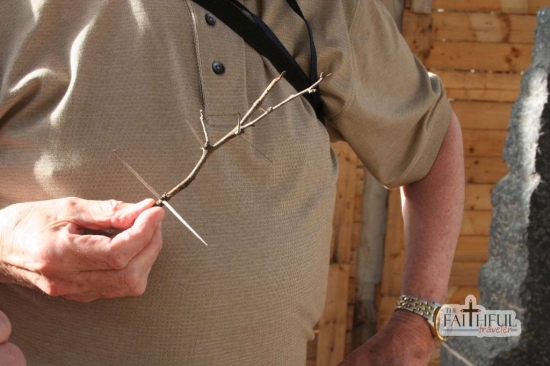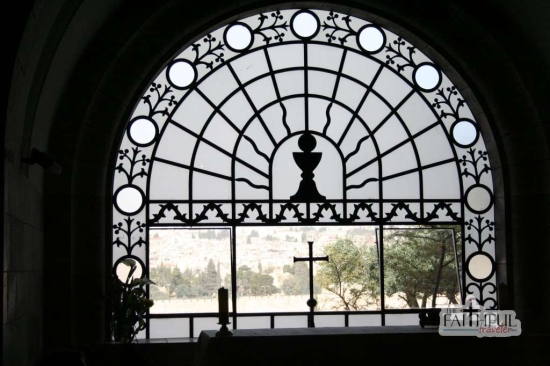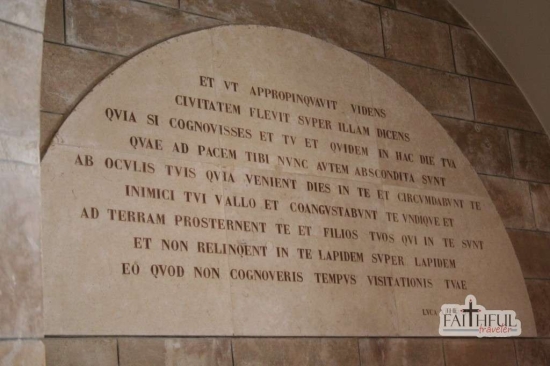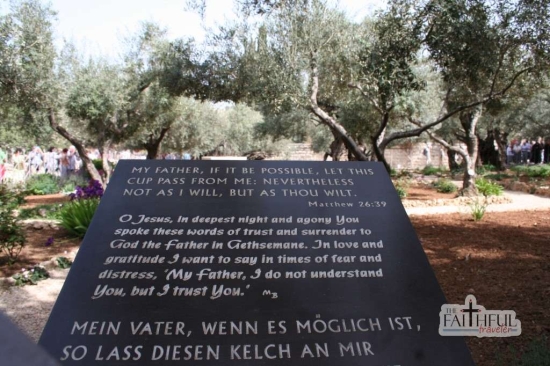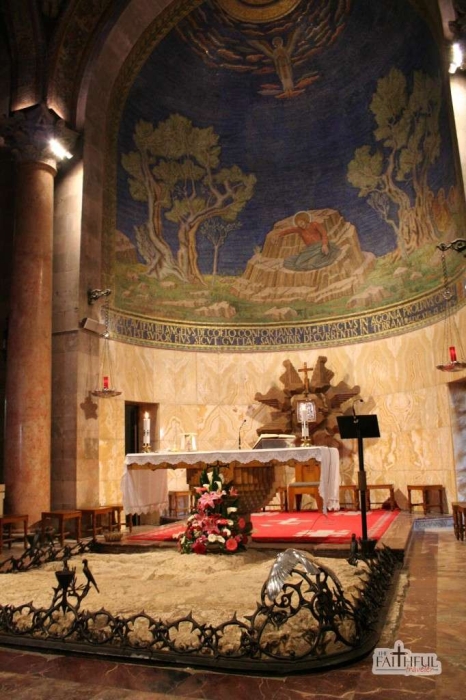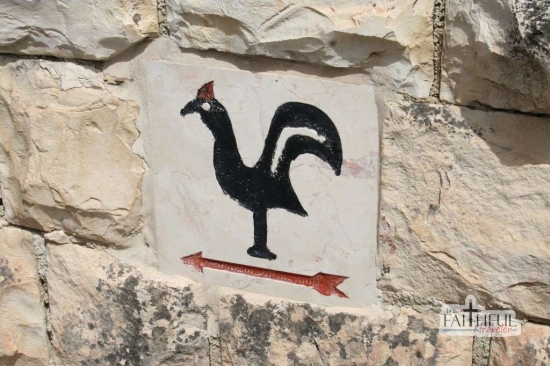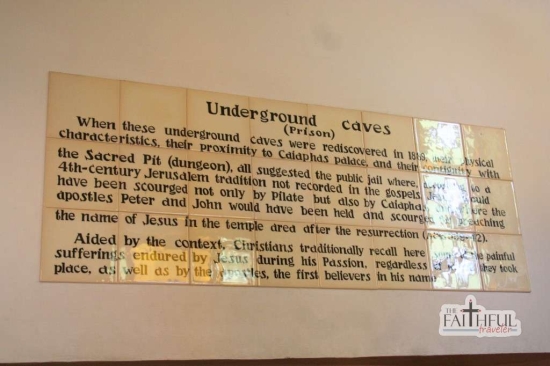On the seventh day of our pilgrimage to the Holy Land, my team had a casualty. David stayed in the hotel that day, because his legs had swollen from the knees down, after having fallen on the Via Dolorosa the previous morning. Our pilgrimage was almost over—we only had two days to go—and his swelling was going down slowly, but still, his condition worried me, and set the stage for this day’s events.
Day 7 focused on the sites of Christ’s Passion, which we celebrate today on Good Friday. Why is it GOOD, I always used to wonder? What’s GOOD about Jesus dying? Ha. It reminds me of something a friend once asked after she watched an early version of our episode on the St Rita of Cascia Shrine in Philadelphia: “So, this woman had a thorn in her head that hurt and stank, and that was a blessing?!”
Perhaps the fact that today is Good is what confounds so many people about the Church’s view on suffering. It is good that God suffered and died for us; for without that sacrifice, we’d be doomed. What more need be said?
On this day, we visited the Church of Pater Noster on the Mount of Olives, where Jesus taught his disciples how to pray through the prayer we now call the Our Father. There, surrounded by tiles with the prayer written in languages from around the world, we encountered an eerie foreshadowing of what we’d see later on: we found a tree full of inch-long thorns.
 It was from the branch of a tree like this, our guide told us, that the soldiers fashioned Jesus’ painful crown.
It was from the branch of a tree like this, our guide told us, that the soldiers fashioned Jesus’ painful crown.
From here, we walked to the Church of Dominus Flevit, which means in Latin “The Lord Wept”. The Church was built in the shape of a tear, and has a beautiful window, overlooking the city of Jerusalem.
“As he drew near, he saw the city and wept over it, saying, “If this day you only knew what makes for peace—but now it is hidden from your eyes. For the days are coming upon you when your enemies will raise a palisade against you; they will encircle you and hem you in on all sides. They will smash you to the ground and your children within you, and they will not leave one stone upon another within you because you did not recognize the time of your visitation.” (Luke 19:41-44)
Further down the Mount of Olives, we entered the Garden of Gethsemane, where Jesus went after the Last Supper, and where he was betrayed by Judas.
We learned that many of the trees here were more than 2,000 years old, meaning that these were the VERY trees that witnessed the saddest night in history.
We celebrated Mass inside the absolutely amazing Basilica of the Agony, the Sanctuary of which contains the rock that is believed to have been the rock on which Jesus prayed the night of his betrayal.
I got to kiss the stone twice. It was one of the highlights of the trip for me. I’ve always had a special devotion to the Agony in the Garden. Christ’s words to Peter, James, and John haunt me: “Could you not keep watch for one hour?” (Mk 14:37) We ask so much of God. Is an hour of our time too much to give back to him; in adoration, during Mass, on a daily basis?
Then, we went to the Church of St Peter in Gallicantu*, the Church built on top of the palace of Caiaphas, the High Priest. It was here that Jesus was condemned by the Sanhedrin, where he was imprisoned overnight,
 and where St Peter denied Christ three times.
and where St Peter denied Christ three times.
 “Gallicantu” comes from the Latin for “cock crow”; “galli” refers to the rooster or cock (in Spanish, its gallo) and “cantu” refers to his crow or song (in Spanish, canto is song).
“Gallicantu” comes from the Latin for “cock crow”; “galli” refers to the rooster or cock (in Spanish, its gallo) and “cantu” refers to his crow or song (in Spanish, canto is song).
I love this sign, because it is so seemingly innocuous and cute. “Roosters this way!” it says cheerfully. But in reality, it says, “This way for the spot where the first pope, where the Rock on which this Church was built, where one of the beloved and trusted betrayed his Lord and Master, not once, not twice, but three times.”
I can’t help but hear it then ask, “How many times have YOU betrayed him?”
As I said earlier, David’s condition was on my mind that day, as was my worry that we’d be able to get everything we needed to get with only one camera person. But God was good to us on this trip, as I’ve said before. Because a few days earlier, we’d been given the opportunity to film the Mount of Olives and its beautiful vistas when one of the tour guides took my team on an early morning tour.
My worries were lessened as I realize, “Hey! We’ve already shot this!” And I was somewhat able to enter into the story behind the locations we visited.
But at the Church of St Peter in Gallicantu, I was still a little discombobulated, to be quite honest. It is hard to focus when you’re trying to make sure you get everything you need for the camera, and I was snapping away with mine. I saw this sign
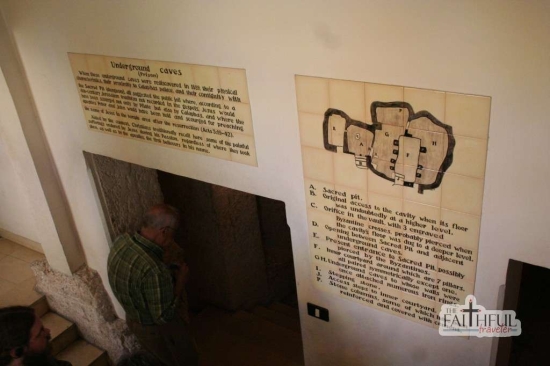 and thought, “Ooh! I might need that later to remind me of what I saw!”
and thought, “Ooh! I might need that later to remind me of what I saw!”
But I didn’t read it.
Next thing I know, we’re in a tiny cave, and Father Donovan is reading something or praying something, and Cardinal Rigali says something, and the next thing I know, the lights go out, and I’m confused…
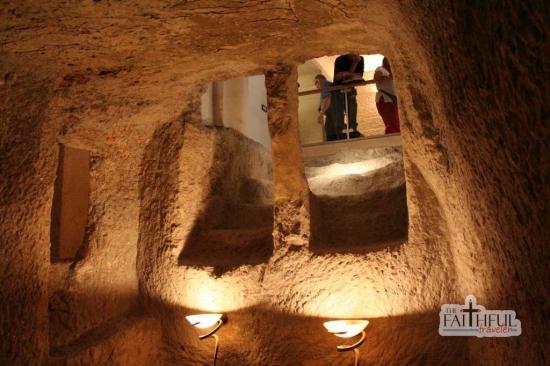 ‘Did they do that on purpose?’ I thought. ‘Ha! Someone accidentally shut the lights out!’ (It’s amazing how fast your mind works, because this all happened—I kid you not—in about a second.)
‘Did they do that on purpose?’ I thought. ‘Ha! Someone accidentally shut the lights out!’ (It’s amazing how fast your mind works, because this all happened—I kid you not—in about a second.)
And then, the sudden wail from a pilgrim snapped me into focus. This was a place of pain. A place of sorrow. This was where Jesus spent the night of Holy Thursday, after having been betrayed by almost everyone He loved, after having been rejected by those He came to save, after having been accused of all number of ridiculous things, and abused in all number of ways, THIS was where He spent the night.
In the darkness. In the cold.
I want to believe that the angels came and kept him company this night. But who knows. Maybe He was denied that consolation, too, to make His sacrifice more perfect.
And that wail of sorrow suddenly made more sense than any worry I had about the show or David or anything. Talk about putting things in perspective.
As I lay in bed last night and thought about the day’s events, in 2011 and 2011 years ago, again my mind raced. The night starts off so quietly: Christ has dinner, and then proceeds to wash the feet of His disciples. But He doesn’t just wash their feet, He tells them, “If I, therefore, the master and teacher, have washed your feet, you ought to wash one another’s feet.” (Jn 13:14)
When I heard this at Mass, my simple, childish, and absolutely 100% Diana reaction was, “Ugh! I HATE FEET!” I do. I have feet issues. I think they’re nasty. Not that I don’t appreciate my feet… I do. But… suffice it to say I have some serious feet issues. And I thought, ‘Seriously? I have to WASH OTHER PEOPLE’S FEET?!’ And then I thought about St Francis and the leper. Have you heard the story? It’s a good one.
I would say that St. Francis felt the same way about lepers as I do about feet—didn’t like ‘em, and certainly didn’t want to TOUCH them! This was a societal thing—leprosy was a horrible disease, and people who had it had to ring a bell to let people know they were coming! (So sad!)
The Vatican website has an awesome telling of this story here, saying, “So greatly loathsome was the sight of lepers to him at one time, he used to say, that, in the days of his vanity, he would look at their houses only from a distance of two miles and he would hold his nostrils with his hands.”
But one day, Francis encountered a leper and it changed his life. I’m sure, if we were to translate Francis’s initial thought into modern parlance, it would be something like, “ Ugh! Can I run and hide? No! Darn! He SAW ME!” You know the scenario.
I love how this website explains his response: “[I]n a decisive moment of illumination, Francis suddenly perceived in this leper the embodiment of God’s beauty, a human being to be loved and cared for tenderly.”
And he kissed him.
So, on this night, just before He takes our sins upon Himself and dies for our redemption, God Himself gives us a new Commandment:
“[L]ove one another. As I have loved you, so you also should love one another. This is how all will know that you are my disciples, if you have love for one another.” (Jn 13:34-35)
Notice how he doesn’t say, “People will know you are my disciples by how many prayers you know, or by how often you go to Mass, or by how pious you seem, or by what you wear, or by how you look or __________ (insert other silly nonsense here).”
But by whether you have love for one another.
And sometimes, loving your “neighbor” is as hard as kissing a leper or washing someone’s feet. It’s forgiving the woman who told you she needed to sit in your seat in church because she had to do a reading, and then she never ended up reading anything. It’s forgiving the driver who almost caused you to hit her with your car head on because she turned in front of you and then stopped in the middle of the road. It’s forgiving the people who ________ (insert other silly nonsense here).
Today is Good Friday, and today, the sorrow continues and grows in intensity. Today at 3 pm, we commemorate the death of our Savior. And if we do go to church and pray and cry and sing, we also must walk out and love and LOVE and forgive. Because if we don’t do both, it’s all meaningless.
Have a GOOD Good Friday everyone.
“If I speak in human and angelic tongues but do not have love, I am a resounding gong or a clashing cymbal.
And if I have the gift of prophecy and comprehend all mysteries and all knowledge; if I have all faith so as to move mountains but do not have love, I am nothing.
If I give away everything I own, and if I hand my body over so that I may boast but do not have love, I gain nothing.”
(1 Corinthians 13:1-3)


